

BIFGA Spring farm walk 2016.............
The BIFGA Spring Farm Walk was held this year on Wednesday 11th May at Broadwater Farm at East Malling in West Kent.
The weather had been a mixture; during the morning as rain clouds circled, dry periods gave way to heavy showers, before the sun came out again in the afternoon. At 4pm as we gathered at Broadwater Farm the temperature was perfect, the skies more settled, but always a suspicious cloud in the distance............
The programme for the evening; a tour of the apple orchards including Gala, Braeburn, newly planted Jazz and Bramley under the guidance of Peter Checkley, who has been managing Broadwater Farm for 13 years.
The orchards are mainly on Class 1 good quality sandy loam and amount to 83 hectares of top fruit. The farm has a naturally high water table - the farm is not named 'Broadwater Farm' without good reason.
Below: Farm Manager Peter Checkley welcomed more than 50 growers and industry representatives to Broadwater Farm
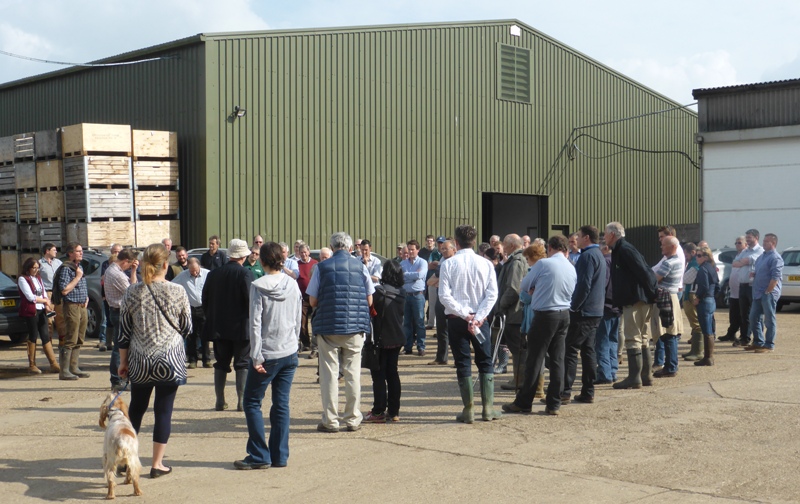
In his welcome, Peter Checkley made BIFGA members aware of a demonstration of a Munckhoff orchard sprayer and a Darwin blossom thinner before we set off for the walk around some of the orchards.
Maintaining good control over scab & mildew is important and an efficient sprayer with good air distribution is critical to the control of these prime diseases. The 'triple fan' Munckhof model complies with the strict emission standards (90% spray drift limiting).
Below: Peter Checkley briefs BIFGA members on the programme for the farm walk - and - a Munckhoff sprayer demonstration in progress
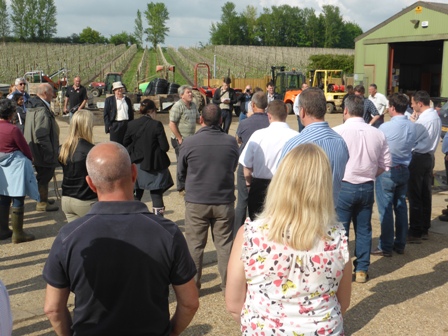
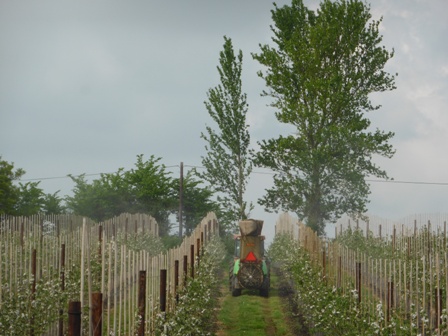
The Triple fan model will ensure that the product penetrates thoroughly into the branches even under difficult conditions. To watch a YouTube demonstration of the sprayer working - click on Munckhof Triple Fan Sprayer
The demonstration of the Darwin 'blossom thinner' which is designed to remove the early blossom from trees with a high yield potential; e.g. Gala, Jazz, Braeburn; this reduces the amount of hand thinning and delivers a more uniform sized fruit at harvest.
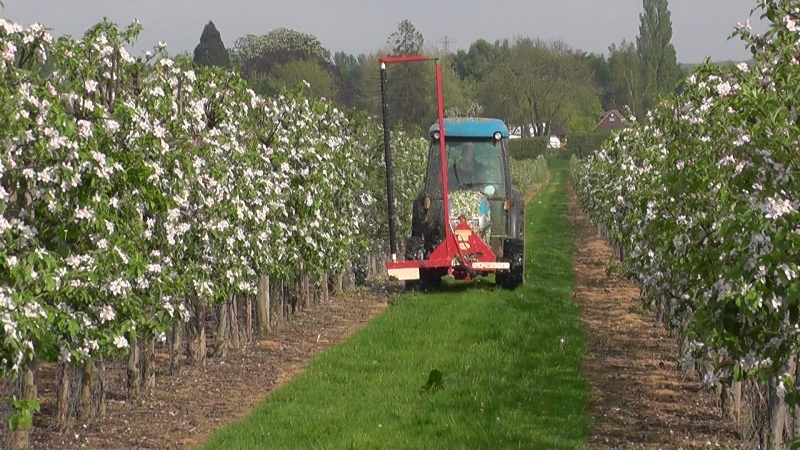
Below: the Darwin in action - the spinning plastic flail is calibrated to remove the targeted amount of flowers; forward tractor speed and speed of the flail are integral to correct calibration
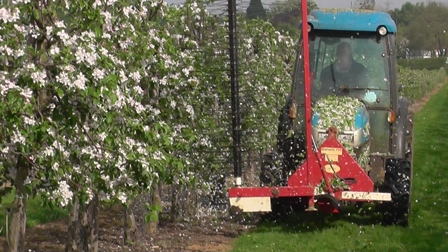
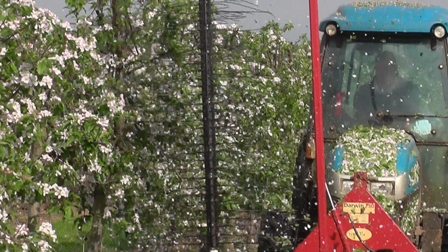
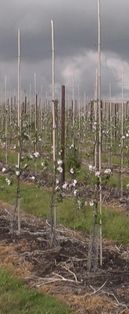 Peter Checkley has embraced mechanical pruning and thinning as an integral part of his orchard management structure. Always aware of the need to keep costs to a minimum, even more so with the introduction of 'the living wage' Peter is gradually changing the orchards over to one simple system. The plan is to have a uniform system across the whole farm, with trees planted 1 metre apart in the rows and 3.5 metres between each row with a tree height of 3 metres.
Peter Checkley has embraced mechanical pruning and thinning as an integral part of his orchard management structure. Always aware of the need to keep costs to a minimum, even more so with the introduction of 'the living wage' Peter is gradually changing the orchards over to one simple system. The plan is to have a uniform system across the whole farm, with trees planted 1 metre apart in the rows and 3.5 metres between each row with a tree height of 3 metres.
Answering a question on whether a narrower alleyway - 3 or 3.25 metres, might be better, Peter agreed with the narrower fruit wall profile, that would be possible, but all the farm equipment fits easily into a 3.5 metre alleyway and that is the defining factor.
While standing by the 'run through' trees, Peter pointed to an older Gala orchard nearby; this had been originally a standard spindle tree with base branches carrying fruiting laterals; Peter told us by converting the 'well established' trees to a fruit wall by mechanical pruning (not the ideal way to create a fruit wall) yields and quality had improved considerably.
By planting 'run through' trees Peter believes the perfect tree shape can be quickly achieved ensuring early and consistent cropping.
Below: 'run through trees'
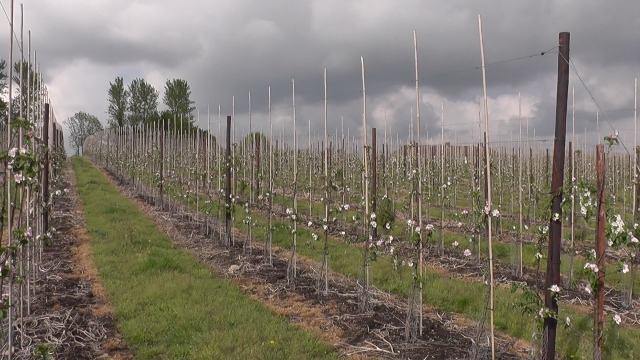
Peter explained the trees are 'headed back' to 1.5 metres in the nursery and the lower buds (which would become the table branches in a 'standard spindle) are 'rubbed out' producing a tall (run through) tree with less vigorous laterals forming fruit bearing branches early in the tree's development.
Below: Peter Checkley explains the tree format he is seeking and how 'run through' trees from the nursery can speed up the tree shape he is seeking.
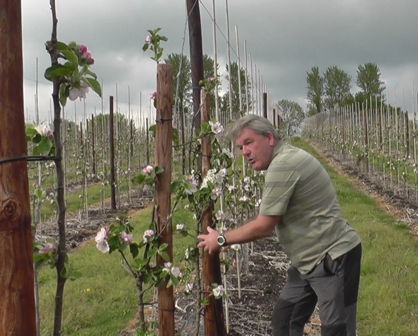
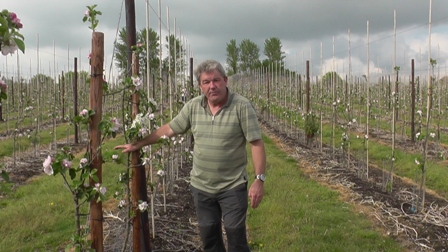
Moving onto a Braeburn orchard planted in 2004, Peter highlighted the mechanical pruning strategy which is facilitated by a machine with 5 blades; the 'window pruning' strategy is to cut a window one year and follow this with second window cut a little higher in the tree; in the third year of the window pruning no window cuts are made. This strategy ensures sufficient light penetration and reduces the need for hand pruning. Peter estimates 80-90% of pruning will be 'mechanical' across the life of the tree. Asked how long he expects the trees to last, he expects a 15-20 year life cycle. Peter said yields are regularly over 50 tonnes per hectare and this orchard has reached between 60 and 70 tonnes per hectare. He is quite happy with 50 tonne crops of the right quality.
Below: Peter explains how his mechanical pruning machine 'cuts windows' into the 'fruit wall' allowing good light penetration and reducing the need for 'hand pruning' to a minimum
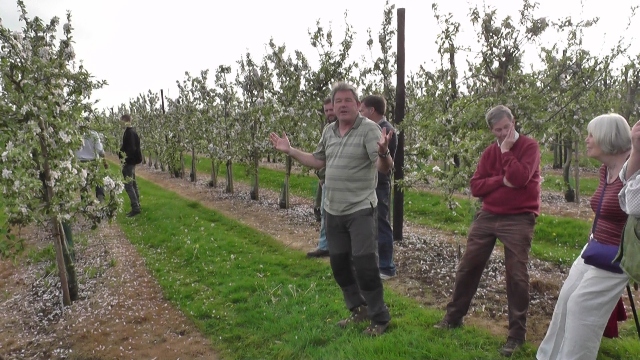
Asked about total yields, Peter said the business strategy was to maintain 10,000 bins annually. The strategy is dictated by the farm infrastructure - their is storage for 10,000 bins, machinery in place for managing that annual yield - regular farm staff of three and accommodation for 80 harvest workers. To expand beyond 10,000 bins would need investment in new store, more bins, more equipment, more accommodation + an other house for another regular farm worker.
Following the farm walk we sat down for 20 minutes to hear the latest development from Landseer - Colin Carter took us back in time to when simple moth traps with hormone attractants allowed growers to record weekly 'catches' for Codling and Tortrix moths making the timing of sprays more effective....
Moving onto Trapview - Colin emphasised Trapview is a 'real time' system delivering much greater accuracy to moth activity. It is a 'quantum leap forward' in pest forecasting technology..............
Below: BIFGA Chairman John Breach introducing Colin Carter - General Manager at Landseer Limited who updated attendees on Trapview development.
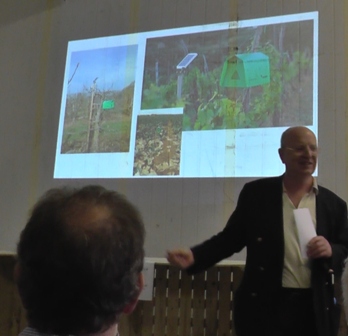
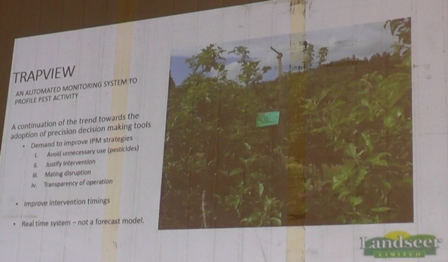
One example of the 'many benefits' of Trapview involves Pear production and their particular attraction to Codling moth - this results in small 'entry points' in the fruit which are not always noticed at harvest time and find their way into storage bins causing high levels of rots in store . An important issue is when to spray to kill Codling without compromising Pear sucker (Psylla pyricola) control being achieved via Anthocorid bugs which are voracious predators of all life stages of pear sucker
To see Trapview in action click on TRAPVIEW and watch YouTube Video
That's all for this week....its 11.15pm on Friday 20th and time for bed!
Next week a look at crop prospects.........right now its Crystal Ball stuff!!!!!!!!
Take care
The English Apple Man